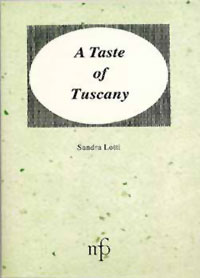 Sandra Lotti
Sandra Lotti
pp. 68, f.to 12×16,5, 2006
ISBN 978-88-7246-315-4
€ 5
Everybody loves Tuscany for their own special reasons, among them art, architecture and the beauty of the landscape. But in the last few years Tuscany has become known as Italy’s jewel for its cuisine, which, in a certain way, is related to art itself. This central region of the country, in fact, embodies all the features one thinks of when one thinks of Italy: beautiful Medieval and Renaissance cities; walled hill towns situated in the middle of nowhere; rolling countrysides with neverending olive groves and vineyards, that produce the best olive oil and wine in the world. The ancient Etruscans were epicures, as are modern Tuscans, and glorious meals are a big part of our lifestyle. Everybody knows the famous Ribollita Soup, and Fiorentina steak, but not everyone knows that the area’s best-kept secret lies with its humblest ingredients: beans and bread. Saltless, rustic and yet the best partner to tuscan cured meats and pecorino senese cheese, bread is the main ingredient in Tuscan cuisine. What would Cacciucco, the most famous fish soup from Viareggio and Livorno, be without a slice of peasant style bread rubbed with garlic? Europeans consider this region the food center of Italy for its wines, cured meats and pecorino cheese. But Tuscany has also had a terrible past and if what you see now glitters as gold, it once was as dull as iron because of the many wars and plagues, especially the one in 1527. The Maremma for example, where the Etruscans lived, was initially a severe and marshy land, but thanks to the Austrian family Lorena who, after Gian Gastone Medici’s death in 1734, reclaimed the land, this southern valley is nowadays the agricultural engine of this region and a hunter’s Eden. With this and other past problems resolved, Tuscany now offers the most varied landscape in Italy with its lakes, mountains, hills, valleys and sandy beaches. The best olive oil and wines come from this region as does the famous and rare white marble and the prized white truffle from San Miniato. The famous saying “If you go to the Maremma you are rich in a day and you’ll die in a year” is now discredited to the point where railroad conductors have stopped ordering people to shut the windows as trains cross the region. The scenery is breathtaking: Saturnia, the Etruscan Aurinia, obscured by the sulphurous vapours of its falls, appears like Dante’s Inferno; Pitigliano, Sovana, Grosseto and many other hill towns dot this green happy land. Driving through Tuscany today, you can lose yourself in the vision of the widespread fields of sunflowers brilliant under the blazing sun ubiquitous to this area. You can also feast your eyes on the limitless green of the wheat and the red clay color of the earth. Breathe more deeply than ever, ingesting the fresh and scented air, a rare quality that once breathed becomes part of you and forces you to come back. Join me in this adventurous cooking trip, take your time and be a little bit Tuscan. You will discover delicious recipes that tell the story of the great cooking of this magic countryside!




Comments are closed.